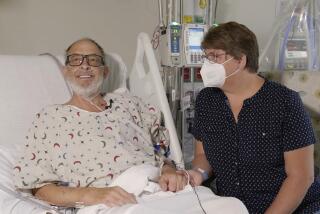Surgeon Tells of ‘Catastrophic’ Decision : Baby Fae’s Death Traced to Blood Mismatch Error
MONTEREY, Calif. — Baby Fae died because of a “catastrophic” medical decision to transplant the heart of a baboon that had a different blood type, the surgeon who performed the operation said Tuesday.
As a result of the blood mismatch, the infant developed antibodies to her own red blood cells, causing her blood to clot, Dr. Leonard L. Bailey of the Loma Linda University Medical Center told the annual meeting of the California Perinatal Assn. here.
When Baby Fae died 20 1/2 days after the transplant, her kidneys were “stuffed” with “abnormal” red blood cells, and thus unable to work, he said.
The failure to match blood types was “a tactical error that came back to haunt us,” Bailey said.
The infant’s blood was type O and the baboon was type AB.
“If Baby Fae had the type AB blood group she would still be alive today,” Bailey said.
The infant was born Oct. 14, 1984, in Barstow with an almost invariably fatal heart disease called hypoplastic left heart syndrome. She received a baboon heart at Loma Linda on Oct. 26, the first infant ever to receive an animal heart transplant.
She was identified only as Baby Fae, at the request of her parents.
Originally, it was thought that rejection of the heart or kidney damage by the anti-rejection drug cyclosporine-A may have caused her death. But the autopsy showed only “minimal” signs of rejection in the heart and no evidence of drug damage to the kidneys, the surgeon said.
In a comprehensive review containing significant new information about the controversial transplant, Bailey also showed a 16-millimeter film of the operation as well as color slides of the autopsy.
The surgeon, who has largely refrained from public comment on the case, appeared relaxed and told several jokes in the course of his 45-minute presentation to more than 200 physicians, nurses and other health care workers. He declined to elaborate or clarify his remarks to reporters after the meeting.
Problems Detailed
He also provided new details about the immunologic problems he and his team encountered after the surgery.
Bailey said the decision not to match the blood types of Baby Fae and the baboon was based on a mistaken belief that the differences between blood types would be less a problem than the differences between species.
Blood types are determined by proteins on the surfaces of blood cells that vary between individuals. Blood can generally only be transfused between individuals of the same blood type.
Bailey also reasoned that the baby’s immune system was immature and could be blocked by large doses of anti-rejection drugs.
Moreover, baboons with type O blood are rare and Bailey had none available when Baby Fae was dying. “We came to regret all these decision-making processes,” he said.
Publication Planned
Bailey said an account of his work would be published by the Journal of the American Medical Assn. A spokesman for the monthly journal said that, as a matter of practice, it does not comment on any articles that may or may not be in the works.
Bailey said Baby Fae’s mother was aware of all the autopsy findings. He said the parents had asked for the autopsy.
He said the mother had read the manuscript of the article for the journal.
The surgeon also said that approval from the Institutional Review Board at Loma Linda for further transplants has “run out” after one year, and a renewal has been applied for.
Bailey said that, in future heart transplants, blood types of the donor and the recipient will be matched and that he would use either human or baboon hearts, “depending on what donors are available.”
Basis of Criticism
Last year some physicians and medical ethicists criticized Bailey for not having searched first for a human heart before implanting the baboon organ in Baby Fae. And Bailey on Tuesday said that it was “an oversight on our part not to search for a human donor right from the start.”
That search began three days after the transplant. No human heart was found before the baby died.
Bailey also defended his continued work in cross-species heart transplantation, reiterating his belief that surgical procedures attempting to treat hypoplastic left heart syndrome, such as the one developed by Dr. William Norwood, are inadequate. This congenital malformation is a condition in which the side of the heart that pumps blood to the body fails to develop.






